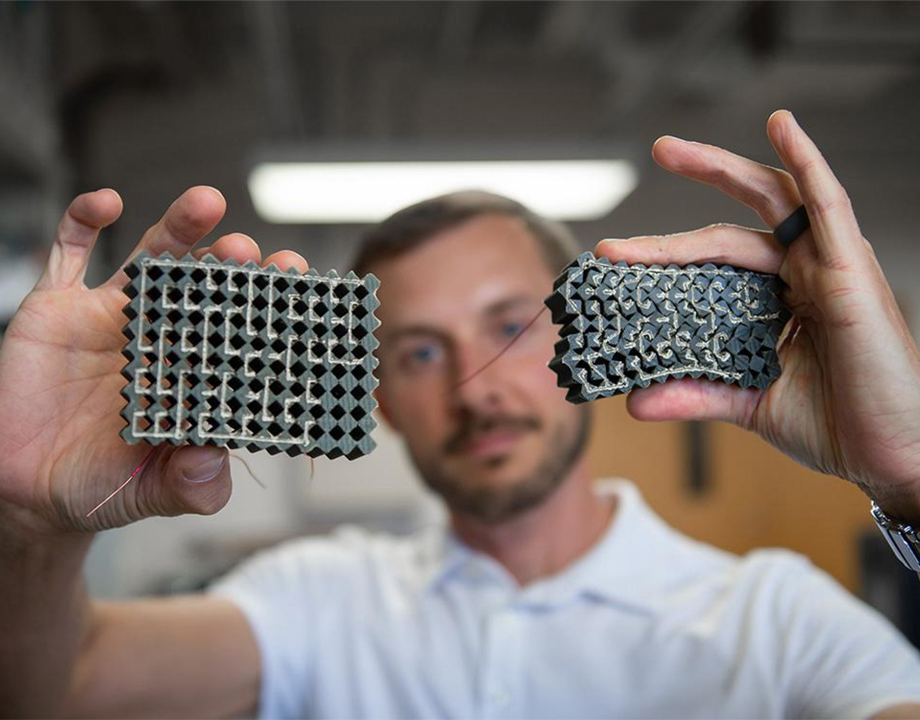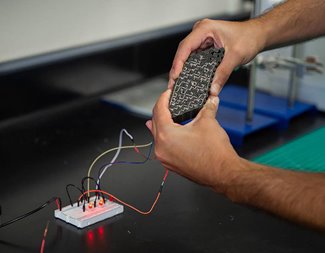If It Only Had a Brain
If It Only Had a Brain


Penn State researchers create mechanical integrated circuit materials from conductive and nonconductive rubber materials that sense and react to tactile input. Photo: Kelby Hochreither/Penn State.
Ryan Harne has always urged the young mechanical engineers on his research team to overcome a challenge by thinking in unexpected ways. When stuck, he said, take a path that’s different than the obvious. By doing so, the team recently gave materials the ability to “think” and perform complex computations in new and novel ways.
“We’re often stuck thinking in the same dimensions, and we try to solve problems just by using the frame of reference we’re looking at. As engineers we can get really pigeonholed,” said Harne, the James Will career development associate professor of mechanical engineering at Penn State and lead author of “Mechanical Integrated Circuit Materials,” published in Nature. “I often tell my students to think in another form of dimension. That helped us reach that lightbulb moment.”
Several lightbulbs, powered by engineering breakthroughs, unique approaches, curious exploration, and out-of-box thinking, popped at different stages of the work. The research highlights the team’s creation of sensor-actuator materials that use embedded intelligence to process complex information and make decisions without being wired to an external computing source.
These soft integrated circuits act as mechanical-electrical networks and could eventually be used in applications such as robotics for construction or to aid people in lifting heavy objects; advanced haptics in the suits, gloves and other tools used in augmented reality; and morphing aircraft to self-correct problems like surface flutter or unnecessary friction. The U.S. Air Force is helping to support the team’s research.
“In those types of applications, you might as well have this type of distributed network of sensor actuators that are self-aware and have their own built-in intelligence. That's where our technology would fill the gap,” Harne said. “If every actuator had its own embedded means for signal processing, which is created through what we demonstrate, then all of a sudden you have a very streamlined enabler for advanced haptics,” and other applications.
He and his team began the first steps of related research several years ago, eventually published in Nature Communications in 2021, by building logic gates in a conductive material (following similar design and construction methods for material used in the latest research) that could “think” about how force is applied to it and respond with programmed reactions. The material was initially intended for soft robotic applications.
More for You: 4 Advances in Soft Robotics
To make the material, the researchers molded a roughly 1.5-inch rubber block consisting of 25 diamond shapes coated with an ink made from small silver flakes and elastomer, creating conductive networks. They ran copper wires on the exposed surfaces of the diamonds, or cells, to serve as electrical connections, which was powered by an external source.
When force is applied to the block, the diamonds squeeze together to form a solid square. That closes the circuits in one of a handful of possible ways, sending the current of information based on the type of force applied. The output information was initially used to light up an LED array, mainly to demonstrate the results of rudimentary digital logic operations.
While the material achieved the team’s goals, it was limited to performing single logic operations that used simple binary input-output functions. But it could not “compare” information, perform arithmetic, or compute higher-level logical operations like traditional microprocessors do in computers and smartphones. In other words, the logic gate material acted as a circuit but fell short of the type of integrated circuit needed to perform complex computations for the applications the researchers envisioned. If the material is considered the brain and the logic gates are its neurons, the team essentially built the building block neurons but had no way to assemble them into a highly functioning brain.
“The big surprise was that we were just thinking about it wrong,” Harne said, adding that the next stage of research would require a different approach to the use and configuration of logic gates.
Sign up: ASME Membership Benefits
Logic gates form the foundation of digital circuits. An integrated circuit is combination of thousands or millions of logic gates, which enables almost any type of modern computer system, including PCs, laptops, and mobile devices. The gates are based on Boolean algebra in which variables are valued at “true” and “false,” denoted by 1 and 0 respectively.
To make integrated circuit materials featured in the new research, the team initially tried the rational approach of physically networking their logic gate materials together. This created a problem: the outputs of the logic gates were electrical while the inputs were a mechanical force or shape. That caused what Harne called a “mismatch” between the output electrical information in one gate that needed to instantly become mechanical information in a subsequent gate. The team hit a wall. It was time to step back and start thinking differently.
While going back to the drawing board, Harne's team remembered interesting comments made in an overlooked 1938 paper, “A Symbolic Analysis of Relay and Switching Circuits,” by Claude Shannon, considered the father of information theory. It was based on the thesis Shannon wrote while earning his master’s degree at MIT. The paper demonstrated that Boolean mathematics applied to electronics could form any logical numerical relationship. It was a revolutionary discovery for the time since integrated circuits and digital computers were a thing of the future.
As part of the research, Shannon proved that switching circuits he had designed earlier to simplify the arrangement of electromechanical relays used in telephone routing switches could solve the same problems Boolean algebra could solve. That concept could easily be transferred to logic gates. This was the lightbulb moment for the researchers. Harne realized that adding intelligence to the material had nothing to do with mechanical assembly and everything to do with math.
“It was just a marvel,” Harne said about Shannon’s research, “because it eliminates the struggle we had between the input-output mismatch of the assembly mindset. Instead, it caused us to think about the whole system and mathematically break it down. That kind of magically gives you the correct assembly for the integrated circuits you use.”
By following the math, Harne realized he simply needed “buffer” and NOT gates, both of which only require a single input and output. A buffer gate passes the input unchanged. The NOT gate, an inverter, is the buffer’s opposite. It changes the value of the 0 input to a 1 (true), or vice versa. In other words, the output is NOT the same as its input. Harne's team ultimately demonstrated an integrated circuit material containing 86 logic gate operations, a far cry from the millions found in computer chips but enough to create a scalable computer out of rubber.
Editor's Pick: Evolution of Autonomous Manufacturing
“It's entirely scalable in the sense that you can basically increase the complexity or computing power to an arbitrary degree, and it still works,” Harne said. “That’s just magical. In a true design process, it can do everything that silicon can do. It is that scalable because we are just following the math.”
To minimize the size of the cube for future applications, the team borrowed layering techniques from silicon chip manufacturers by adding or “hiding” the circuits and wiring on the inside of the material instead of the surface.
“When we realized we should just stack everything into the depth, that design decision had entirely taken us like to a next level of what we could actually demonstrate,” Harne said, adding that the next step in the research could enable the material to “see,” as well as think, by processing visual information to autonomously navigate its environment.
The actual size of the material won’t necessarily grow in the future, but its brain will.
Jeff O’Heir is a science and technology writer in Huntington, N.Y.
“We’re often stuck thinking in the same dimensions, and we try to solve problems just by using the frame of reference we’re looking at. As engineers we can get really pigeonholed,” said Harne, the James Will career development associate professor of mechanical engineering at Penn State and lead author of “Mechanical Integrated Circuit Materials,” published in Nature. “I often tell my students to think in another form of dimension. That helped us reach that lightbulb moment.”
Several lightbulbs, powered by engineering breakthroughs, unique approaches, curious exploration, and out-of-box thinking, popped at different stages of the work. The research highlights the team’s creation of sensor-actuator materials that use embedded intelligence to process complex information and make decisions without being wired to an external computing source.
These soft integrated circuits act as mechanical-electrical networks and could eventually be used in applications such as robotics for construction or to aid people in lifting heavy objects; advanced haptics in the suits, gloves and other tools used in augmented reality; and morphing aircraft to self-correct problems like surface flutter or unnecessary friction. The U.S. Air Force is helping to support the team’s research.
“In those types of applications, you might as well have this type of distributed network of sensor actuators that are self-aware and have their own built-in intelligence. That's where our technology would fill the gap,” Harne said. “If every actuator had its own embedded means for signal processing, which is created through what we demonstrate, then all of a sudden you have a very streamlined enabler for advanced haptics,” and other applications.
He and his team began the first steps of related research several years ago, eventually published in Nature Communications in 2021, by building logic gates in a conductive material (following similar design and construction methods for material used in the latest research) that could “think” about how force is applied to it and respond with programmed reactions. The material was initially intended for soft robotic applications.
More for You: 4 Advances in Soft Robotics
To make the material, the researchers molded a roughly 1.5-inch rubber block consisting of 25 diamond shapes coated with an ink made from small silver flakes and elastomer, creating conductive networks. They ran copper wires on the exposed surfaces of the diamonds, or cells, to serve as electrical connections, which was powered by an external source.
When force is applied to the block, the diamonds squeeze together to form a solid square. That closes the circuits in one of a handful of possible ways, sending the current of information based on the type of force applied. The output information was initially used to light up an LED array, mainly to demonstrate the results of rudimentary digital logic operations.
While the material achieved the team’s goals, it was limited to performing single logic operations that used simple binary input-output functions. But it could not “compare” information, perform arithmetic, or compute higher-level logical operations like traditional microprocessors do in computers and smartphones. In other words, the logic gate material acted as a circuit but fell short of the type of integrated circuit needed to perform complex computations for the applications the researchers envisioned. If the material is considered the brain and the logic gates are its neurons, the team essentially built the building block neurons but had no way to assemble them into a highly functioning brain.
“The big surprise was that we were just thinking about it wrong,” Harne said, adding that the next stage of research would require a different approach to the use and configuration of logic gates.
Sign up: ASME Membership Benefits
Logic gates form the foundation of digital circuits. An integrated circuit is combination of thousands or millions of logic gates, which enables almost any type of modern computer system, including PCs, laptops, and mobile devices. The gates are based on Boolean algebra in which variables are valued at “true” and “false,” denoted by 1 and 0 respectively.
To make integrated circuit materials featured in the new research, the team initially tried the rational approach of physically networking their logic gate materials together. This created a problem: the outputs of the logic gates were electrical while the inputs were a mechanical force or shape. That caused what Harne called a “mismatch” between the output electrical information in one gate that needed to instantly become mechanical information in a subsequent gate. The team hit a wall. It was time to step back and start thinking differently.
While going back to the drawing board, Harne's team remembered interesting comments made in an overlooked 1938 paper, “A Symbolic Analysis of Relay and Switching Circuits,” by Claude Shannon, considered the father of information theory. It was based on the thesis Shannon wrote while earning his master’s degree at MIT. The paper demonstrated that Boolean mathematics applied to electronics could form any logical numerical relationship. It was a revolutionary discovery for the time since integrated circuits and digital computers were a thing of the future.
As part of the research, Shannon proved that switching circuits he had designed earlier to simplify the arrangement of electromechanical relays used in telephone routing switches could solve the same problems Boolean algebra could solve. That concept could easily be transferred to logic gates. This was the lightbulb moment for the researchers. Harne realized that adding intelligence to the material had nothing to do with mechanical assembly and everything to do with math.
“It was just a marvel,” Harne said about Shannon’s research, “because it eliminates the struggle we had between the input-output mismatch of the assembly mindset. Instead, it caused us to think about the whole system and mathematically break it down. That kind of magically gives you the correct assembly for the integrated circuits you use.”
By following the math, Harne realized he simply needed “buffer” and NOT gates, both of which only require a single input and output. A buffer gate passes the input unchanged. The NOT gate, an inverter, is the buffer’s opposite. It changes the value of the 0 input to a 1 (true), or vice versa. In other words, the output is NOT the same as its input. Harne's team ultimately demonstrated an integrated circuit material containing 86 logic gate operations, a far cry from the millions found in computer chips but enough to create a scalable computer out of rubber.
Editor's Pick: Evolution of Autonomous Manufacturing
“It's entirely scalable in the sense that you can basically increase the complexity or computing power to an arbitrary degree, and it still works,” Harne said. “That’s just magical. In a true design process, it can do everything that silicon can do. It is that scalable because we are just following the math.”
To minimize the size of the cube for future applications, the team borrowed layering techniques from silicon chip manufacturers by adding or “hiding” the circuits and wiring on the inside of the material instead of the surface.
“When we realized we should just stack everything into the depth, that design decision had entirely taken us like to a next level of what we could actually demonstrate,” Harne said, adding that the next step in the research could enable the material to “see,” as well as think, by processing visual information to autonomously navigate its environment.
The actual size of the material won’t necessarily grow in the future, but its brain will.
Jeff O’Heir is a science and technology writer in Huntington, N.Y.




